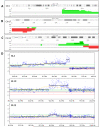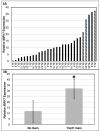Genome wide copy number analysis of paediatric Burkitt lymphoma using formalin-fixed tissues reveals a subset with gain of chromosome 13q and corresponding miRNA over expression
- PMID: 21981616
- PMCID: PMC3204171
- DOI: 10.1111/j.1365-2141.2011.08883.x
Genome wide copy number analysis of paediatric Burkitt lymphoma using formalin-fixed tissues reveals a subset with gain of chromosome 13q and corresponding miRNA over expression
Abstract
The majority of paediatric Burkitt lymphoma (pBL) patients that relapse will die of disease, but markers for this high-risk subset are unknown. MYC translocations characterize pBL, but additional genetic changes may relate to prognosis and serve as potential biomarkers. We utilized a molecular inversion probe single nucleotide polymorphism assay to perform high resolution, genome-wide copy number analysis on archival formalin-fixed, paraffin-embedded pBL and germline tissues. We identified copy number abnormalities (CNAs) in 18/28 patients (64%) with a total of 62 CNAs that included 32 gains and 30 copy number losses. We identified seven recurrent CNAs including 1q gain (7/28, 25%), 13q gain (3/28, 11%), and 17p loss (4/28, 14%). The minimum common amplified region on 13q was at 13q31 and included the MIR17HG (MIR17-92) locus. Samples with this gain had higher levels of MIR17 RNA and showed a tendency for early relapse. Tumour-specific uniparental disomy was identified in 32% of cases and usually was recurrent. These results demonstrate that high-resolution copy number analysis can be performed on archival lymphoma tissue specimens, which has significance for the study of rare diseases.
© 2011 Blackwell Publishing Ltd.
Figures




References
-
- Bea S, Salaverria I, Armengol L, Pinyol M, Fernandez V, Hartmann EM, Jares P, Amador V, Hernandez L, Navarro A, Ott G, Rosenwald A, Estivill X, Campo E. Uniparental disomies, homozygous deletions, amplifications, and target genes in mantle cell lymphoma revealed by integrative high-resolution whole-genome profiling. Blood. 2009;113:3059–3069. - PMC - PubMed
-
- Cairo MS, Krailo MD, Morse M, Hutchinson RJ, Harris RE, Kjeldsberg CR, Kadin ME, Radel E, Steinherz LJ, Morris E, Finlay JL, Meadows AT. Long-term follow-up of short intensive multiagent chemotherapy without high-dose methotrexate (‘Orange’) in children with advanced non-lymphoblastic non-Hodgkin’s lymphoma: a children’s cancer group report. Leukemia. 2002;16:594–600. - PubMed
-
- Cairo MS, Gerrard M, Sposto R, Auperin A, Pinkerton CR, Michon J, Weston C, Perkins SL, Raphael M, McCarthy K, Patte C. Results of a randomized international study of high-risk central nervous system B non-Hodgkin lymphoma and B acute lymphoblastic leukemia in children and adolescents. Blood. 2007;109:2736–2743. - PMC - PubMed
-
- Capello D, Scandurra M, Poretti G, Rancoita PM, Mian M, Gloghini A, Deambrogi C, Martini M, Rossi D, Greiner TC, Chan WC, Ponzoni M, Moreno SM, Piris MA, Canzonieri V, Spina M, Tirelli U, Inghirami G, Rinaldi A, Zucca E, Favera RD, Cavalli F, Larocca LM, Kwee I, Carbone A, Gaidano G, Bertoni F. Genome wide DNA-profiling of HIV-related B-cell lymphomas. British Journal of Haematology. 2009;148:245–255. - PMC - PubMed
-
- Dave SS, Fu K, Wright GW, Lam LT, Kluin P, Boerma EJ, Greiner TC, Weisenburger DD, Rosenwald A, Ott G, Muller-Hermelink HK, Gascoyne RD, Delabie J, Rimsza LM, Braziel RM, Grogan TM, Campo E, Jaffe ES, Dave BJ, Sanger W, Bast M, Vose JM, Armitage JO, Connors JM, Smeland EB, Kvaloy S, Holte H, Fisher RI, Miller TP, Montserrat E, Wilson WH, Bahl M, Zhao H, Yang L, Powell J, Simon R, Chan WC, Staudt LM. Molecular diagnosis of Burkitt’s lymphoma. New England Journal of Medicine. 2006;354:2431–2442. - PubMed
Publication types
MeSH terms
Substances
Grants and funding
LinkOut - more resources
Full Text Sources

